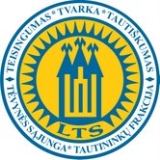
Lithuanian Nationalists Union
Encyclopedia
The Lithuanian Nationalist Union , also known as the Nationalists (Tautininkai), was a nationalist, right-wing political party in Lithuania
, founded in 1924 when the Party of National Progress
merged with the Lithuanian Farmers' Association. It was the ruling party of Lithuania from the 1926 Lithuanian coup d'état in December 1926 to the Soviet occupation in June 1940. The party was re-established when Lithuania declared independence in 1990
.
The party did not enjoy popular support and in the May 1926 parliamentary elections managed to win only 3 seats out of 85. However, its leaders Antanas Smetona
and Augustinas Voldemaras
were popular and influential public figures. The party was conservative and nationalistic; it stressed the need for a strong army and a strong leader.
During the December 1926 coup the military deposed the democratically elected government and invited Smetona to become the new President of Lithuania and Voldemaras the new Prime Minister
. The Nationalists and the Lithuanian Christian Democrats
formed a new government. However, the relationship between the two parties soon became tense as Christian Democrats regarded the coup as a temporary measure and wished to hold new elections to the Seimas
. In April 1927 Smetona dissolved the Seimas and in May Christian Democrats resigned from the government. The Nationalists remained the only party in power for another thirteen years.
After the party was re-established in 1990, it played a diminishing role in Lithuanian politics. In the elections of the Seimas of 1992 the Lithuanian National Union won 4 places; in 1996 - 3 places, and since 2000 it has no representatives. The number of representatives in the regional municipalities is also diminishing: the party won 49 mandates in 1995, 23 in 1997, 13 in 2000, 14 in 2002 and 3 in 2007 elections.
The last leader and chairman of the party was Gintaras Songaila.
On March 11, 2008 Lithuanian Nationalist Union merged in to Homeland Union, but in 2011 they announced their withdrawal from it.
Lithuania
Lithuania , officially the Republic of Lithuania is a country in Northern Europe, the biggest of the three Baltic states. It is situated along the southeastern shore of the Baltic Sea, whereby to the west lie Sweden and Denmark...
, founded in 1924 when the Party of National Progress
Party of National Progress
Party of National Progress or TPP is a political party in Lithuania. It was established in 1916. The party was named by the prominent Lithuanian activist and writer Juozas Tumas-Vaižgantas, who regarded progress as the main aspect of future politics. The party published its main goals in 1917,...
merged with the Lithuanian Farmers' Association. It was the ruling party of Lithuania from the 1926 Lithuanian coup d'état in December 1926 to the Soviet occupation in June 1940. The party was re-established when Lithuania declared independence in 1990
Act of the Re-Establishment of the State of Lithuania
The Act of the Re-Establishment of the State of Lithuania or Act of March 11 was an independence declaration by the Lithuanian Soviet Socialist Republic adopted on March 11, 1990...
.
The party did not enjoy popular support and in the May 1926 parliamentary elections managed to win only 3 seats out of 85. However, its leaders Antanas Smetona
Antanas Smetona
Antanas Smetona was one of the most important Lithuanian political figures between World War I and World War II. He served as the first President of Lithuania from April 4, 1919 to June 19, 1920. He again served as the last President of the country from December 19, 1926 to June 15, 1940, before...
and Augustinas Voldemaras
Augustinas Voldemaras
Augustinas Voldemaras was a Lithuanian nationalist political figure. He served as the country's first Prime Minister in 1918, and again from 1926 to 1929.- Biography :...
were popular and influential public figures. The party was conservative and nationalistic; it stressed the need for a strong army and a strong leader.
During the December 1926 coup the military deposed the democratically elected government and invited Smetona to become the new President of Lithuania and Voldemaras the new Prime Minister
Prime Minister of Lithuania
The Prime Minister of Lithuania is the head of the executive arm of Lithuania's government, and is chosen by the Lithuanian parliament, the Seimas. The modern office of Prime Minister was established in 1990, although the official title was "Chairperson of the Council of Ministers" until 25...
. The Nationalists and the Lithuanian Christian Democrats
Lithuanian Christian Democrats
The Lithuanian Christian Democrats or LKD was a Christian-democratic political party in Lithuania. Originally established in 1905, it was closely associated with the Roman Catholic Church...
formed a new government. However, the relationship between the two parties soon became tense as Christian Democrats regarded the coup as a temporary measure and wished to hold new elections to the Seimas
Seimas
The Seimas is the unicameral Lithuanian parliament. It has 141 members that are elected for a four-year term. About half of the members of this legislative body are elected in individual constituencies , and the other half are elected by nationwide vote according to proportional representation...
. In April 1927 Smetona dissolved the Seimas and in May Christian Democrats resigned from the government. The Nationalists remained the only party in power for another thirteen years.
After the party was re-established in 1990, it played a diminishing role in Lithuanian politics. In the elections of the Seimas of 1992 the Lithuanian National Union won 4 places; in 1996 - 3 places, and since 2000 it has no representatives. The number of representatives in the regional municipalities is also diminishing: the party won 49 mandates in 1995, 23 in 1997, 13 in 2000, 14 in 2002 and 3 in 2007 elections.
The last leader and chairman of the party was Gintaras Songaila.
On March 11, 2008 Lithuanian Nationalist Union merged in to Homeland Union, but in 2011 they announced their withdrawal from it.

